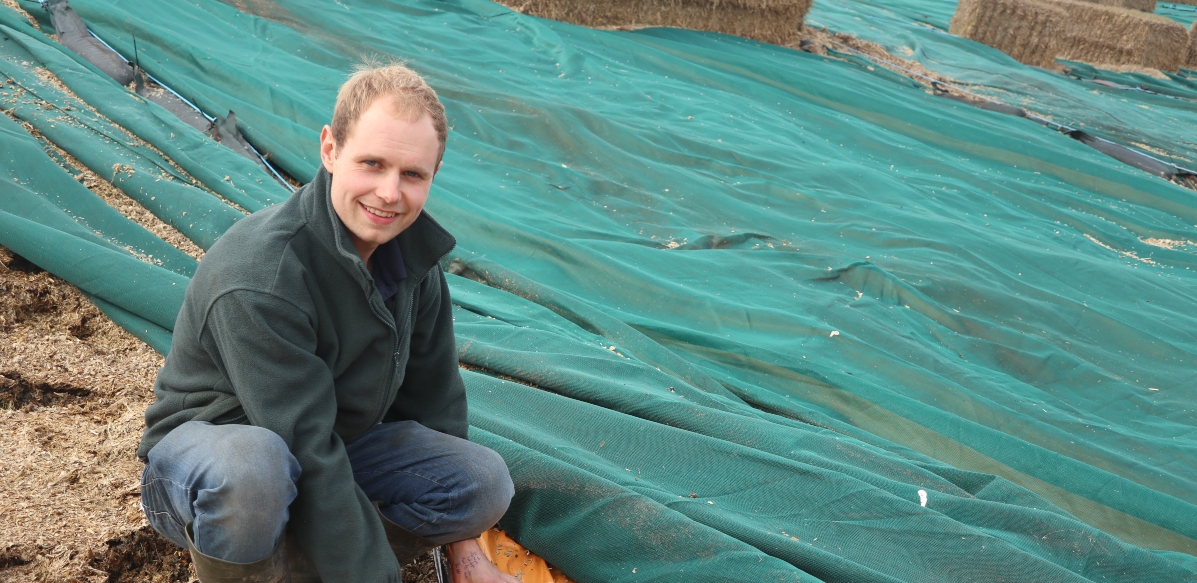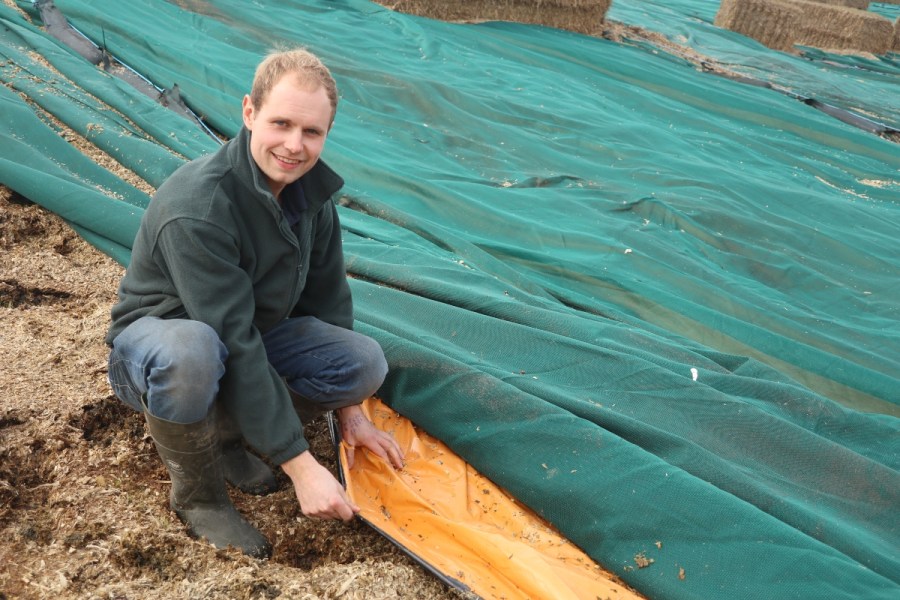
Ten years of producing a diverse range of crops to feed a large gas-to-grid business has reinforced the critical importance of efficient forage conservation at a farm in Kent. CPM visits to find out more.
We’re primarily an arable farm that has transformed into an energy business too.
By Rob Jones
Growing nearly 2200ha of energy crops, and ensuring they stay in the best condition possible after harvesting in order to drive maximum gas production, has been a huge learning curve for the previously arable-based business, says Iain Moss, senior farm manager at St Nicholas Court Farm, near Birchington in Kent.
“Forage management and silage clamps are not really part of the mindset for arable producers but when you’re involved in renewable energy production, they become the foundation of the business,” he says.
“After harvest, we’ve probably got nearly £4M worth of forage sitting in our clamps, so the decisions we make to ensure it’s going to store well and be simple to manage over the following year are of critical importance.
“Our target is zero loss from field to digester and that requires a very specific approach to the harvest process, managing and sealing the clamp at filling, but also it governs how we remove material through the year to feed the digesters.”
Just a decade ago, the business was based around 1300ha of conventional arable production, but the addition of the energy business has seen the total enterprise size grow to nearly 3500ha, he explains.
“During the evolution of the AD plant, Combined Heat and Power (CHP) has given way to gas, with two gas- to-grid digesters with full CO2 recovery now in operation.
“Whilst we grow wholecrop rye and triticale plus some grass silage to supply these, we’re pretty much focused on maize, with up to 1500ha grown each year and this has taken a bit of getting used to in terms of management.
“At first we thought – great, it’s really going to help with controlling blackgrass, but we soon learned the growth habit of maize doesn’t make it particularly effective at this, although it does provide some opportunity for cultural control ahead of drilling.”
The area’s near-continental climate allows the use of later maturing varieties, with KWS Amaroc, Grainseed’s Cathy and RAGT Indexx being some of the highlights in recent years, but drier growing conditions are becoming a concern, says Iain.
“Soil moisture conservation is a priority for us, so we’re very careful with cultivations and how much land we open up before drilling. Everything is rolled once the seed is in and we’re making more use of cover crops to return organic matter back to the soil.
“We’re learning to deal with the variability in yields too. We target 42t/ha freshweight, but yields have been as low as 33t/ha and as high as 51t/ha.
“The gas production process needs a constant supply of forage, so we always aim to grow 15% more than we technically need in any one year, allowing for carry-over stocks and helping even out any production hiccups,” he explains.
“Dry matter drives gas production so as well as high yields, we’re also aiming for 32-35% DM at harvest and in the clamp.”
Such an approach puts a high emphasis on quality and quantity of storage facilities, with the addition of a new purpose-built Ark clamp built in 2014 being a great example of this.
“We saw the Ark clamps in operation in Germany and were impressed. Ours is a two-bay construction measuring 40m across by 140m long and capable of storing over 50,000 tonnes of forage,” he explains.
“The 23o sloping walls of the clamp also allow for safe piling of material above the height of the panels and they allow for improved compaction along the shoulders of the clamp as machinery can work right up to the edge.”
Assistant farm manager Luke Robison says compaction is one of the most important objectives of the clamp filling operation.
“We aim to complete all the maize harvesting and clamp filling in a three-week period, usually in the middle of September, so we can get a first wheat in. This means we’ve got to approach it with almost military precision.
“We’ve run two contractor teams, with at least one tractor and buck rake for each team at the clamp to consolidate material properly. The aim is to keep a steady flow of material entering the clamp at all times,” says Luke.
“Side walls are sealed with a 150-micron side sheet to eradicate the possibility of air entering through the walls once sealed and our aim is to minimise joins in the top sheet as we progress. We’ve used a single-layer Silostop Max oxygen barrier sheet for the past four years as we’ve found this to be the best way of achieving this, while being the simplest approach to use,” he comments.
“Double sheeting is a nightmare from a practical perspective and smaller sheet sizes mean there are many more joins to try to make airtight. This adds time to the sheeting process and increases the clamps vulnerability to the high winds we often experience here.
But there are ways around this, says Luke. “We can use a 27m wide Silostop sheet, which is 150m long so we go right across the 80m width with a single sheet. That way we can cover the entire 140m long clamp with 6-8 sheets in total.
“Any offcuts are used to cover our smaller silage clamps, so no plastic is wasted. Using this method makes it easier to sheet individual sections of the clamp as they’re completed and doing it in bitesize chunks is far less daunting for everybody,” he laughs.
“As we move down the clamp, the side sheets are folded under the top sheet and an ARK secure cover is placed on top with gravel bags used to seal the joins. We’ve found we get zero wastage of forage due to air ingress and spoilage this way, which is pretty impressive for a clamp this size.
“When we open the clamp up, we simply roll the whole sheet back – as much as we need to – with the single layer making the whole operation much easier than with a two-layer approach. “It also means we’re using a lot less plastic than we would be doing with a more traditional two sheet system.”
Iain believes the combination of the right silage clamp to optimise capacity and consolidation together with a single-layer sealing system provides a solid foundation for the energy business.
“The single biggest thing under our control to ensure the long-term viability of the energy business is to make sure we know how to grow the right type and quantity of crops, and that we can keep these in as good a condition as possible before we need to use them.
“None of this has been easy. We’re primarily an arable farm that has transformed into an energy business too. In some ways that’s allowed us to take a slightly sideways look at the best technology available for the job and not just go along with traditional thinking at the time.
“But we are moving forward all the time. We’ve learned some very important lessons in forage production and its conservation and doubtless will continue to do so in the future,” he concludes.
Why diversify into energy?
Saint Nicholas Court Farms is now owned by the third generation of the Tapp family farming at Saint Nicholas-at-Wade, and its venture into energy production is the latest in a long history of innovation.
“Over the years the business has run a large potato and packhouse operation, produced and processed a wide range of vegetables and even had our own flour mill,” explains Iain, who has been farm manager since 2007.
“The decision to look at renewable energy was made in 2011 and we put our first 0.5 megawatt CHP system in during 2012.”
The decision to do so was based on both practical and economic considerations, he says. “At that time the feed in tariff system was a very reliable and dependable income stream that we could bank on, so that obviously appealed.
“But we could also see interesting rotational options for the farm with a view to helping us address weed control issues. The necessary move to a more spring cropping focused approach was also promising in terms of balancing out machinery and labour over the year, and the return of organic matter to the soil was attractive,” he explains.
“You also have to love technology and machinery to get involved with on-farm energy and, unfortunately, I do,” he quips. “So I was always behind the idea and the whole operation has grown from there really.”
As for the future, the objective is to refine the existing system rather than expand it, he says. “I think this is as big as it’s going to get, but there are so many things to learn that I know we can increase the future efficiency of our crop production for the plant and its overall running.
“Forage production and storage is just one of those things, but there are so many more areas where small improvements could really benefit the business, so we’ll keep working on those. But as our history shows, we’re not scared of a challenge.”




